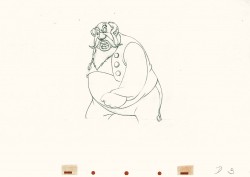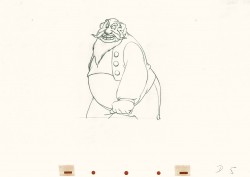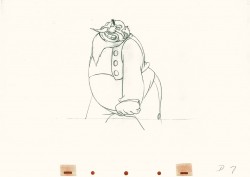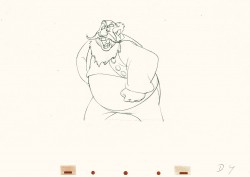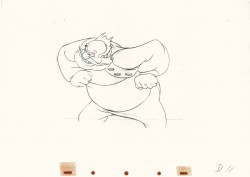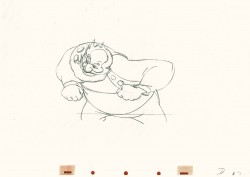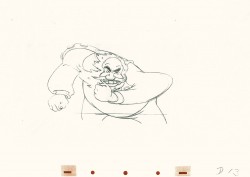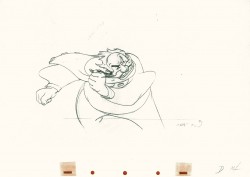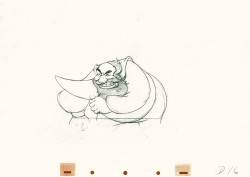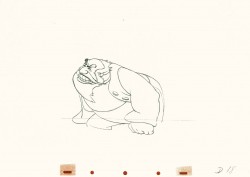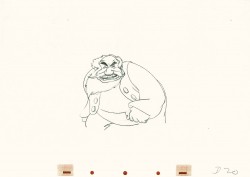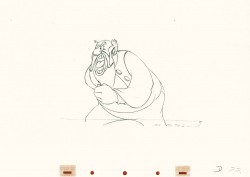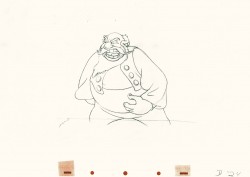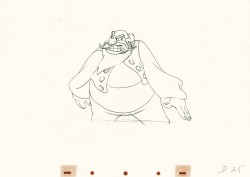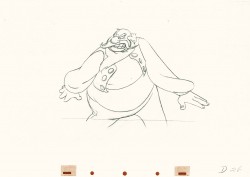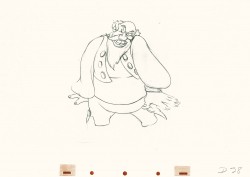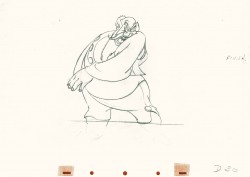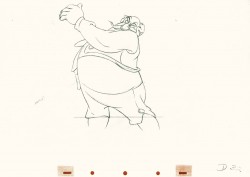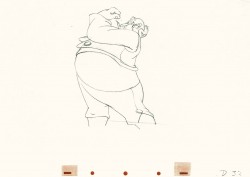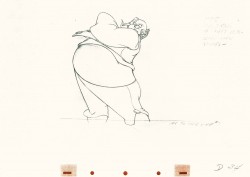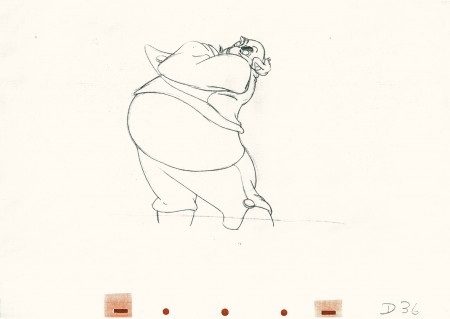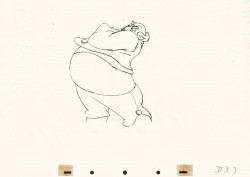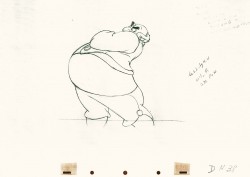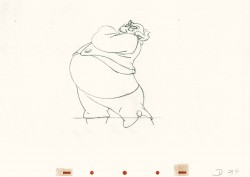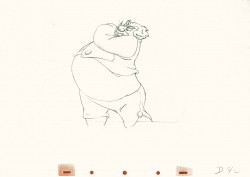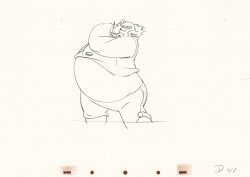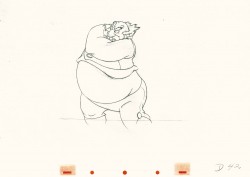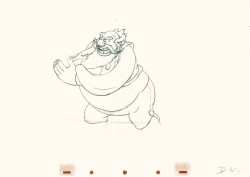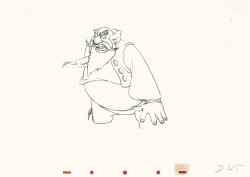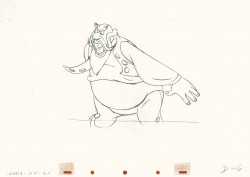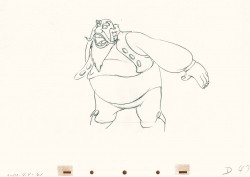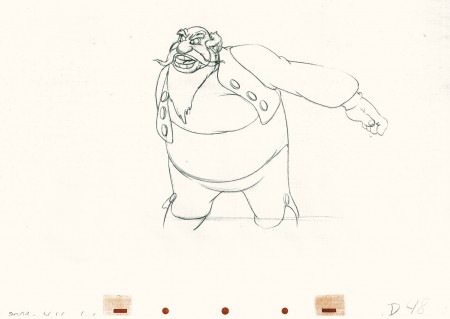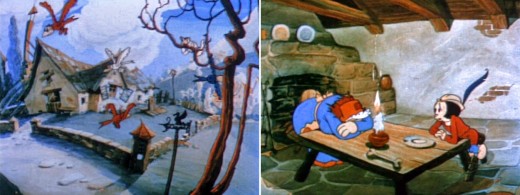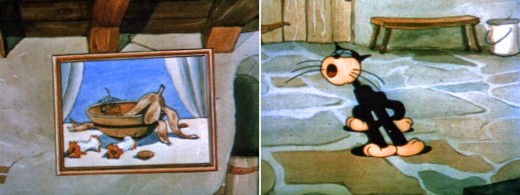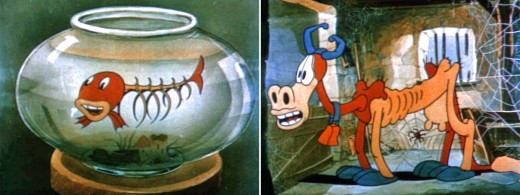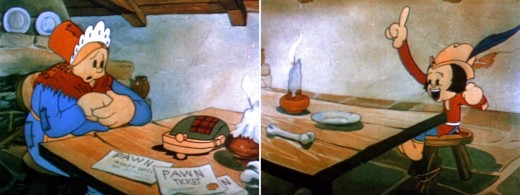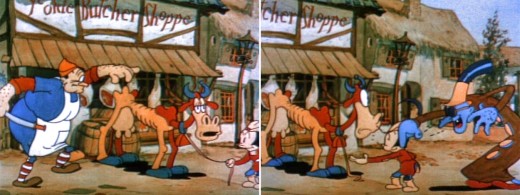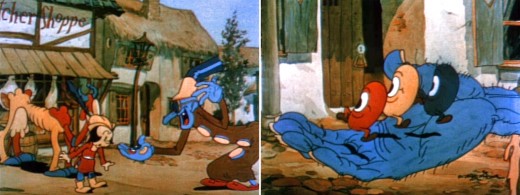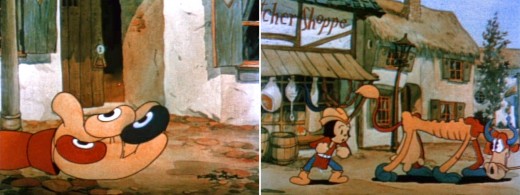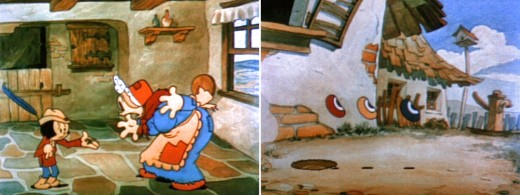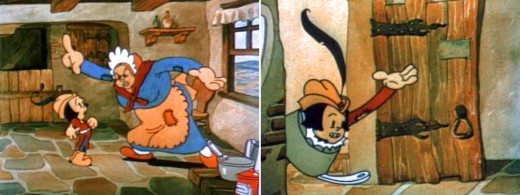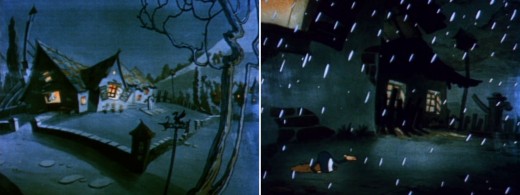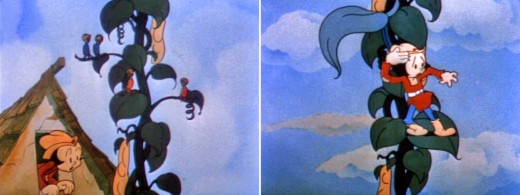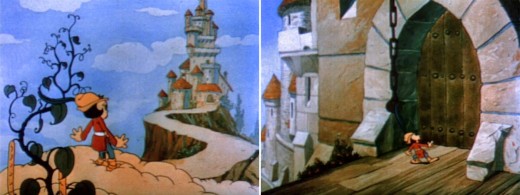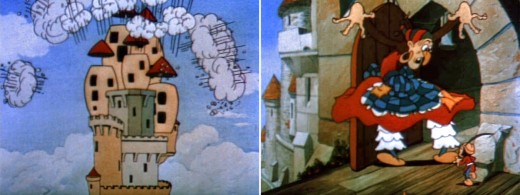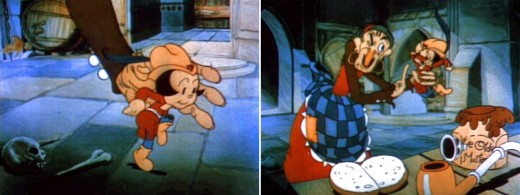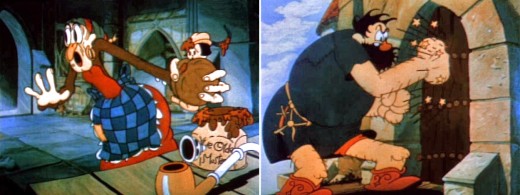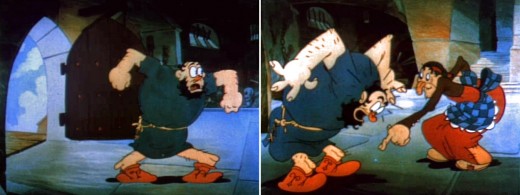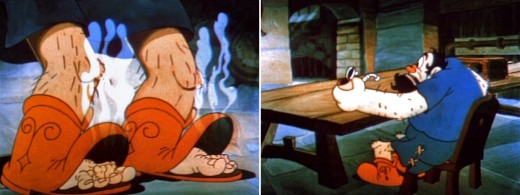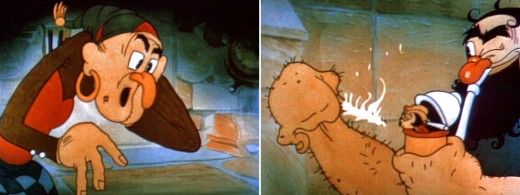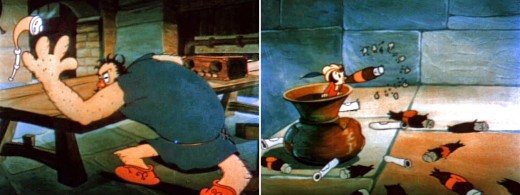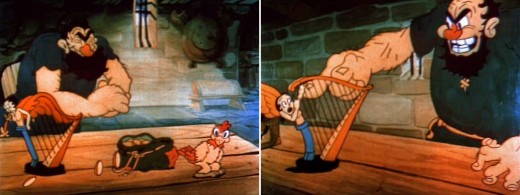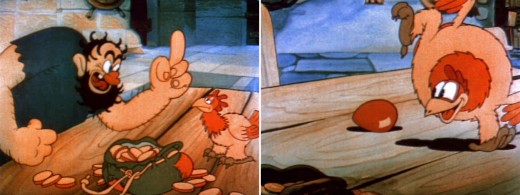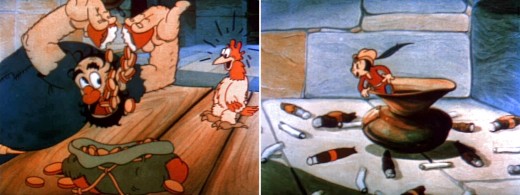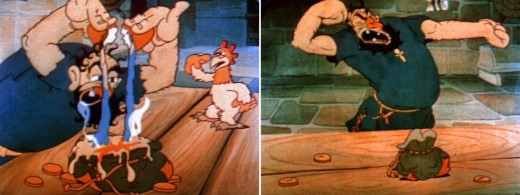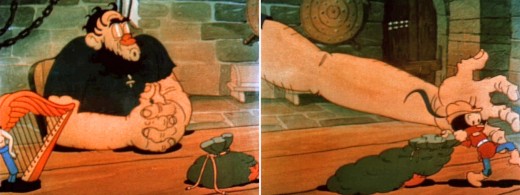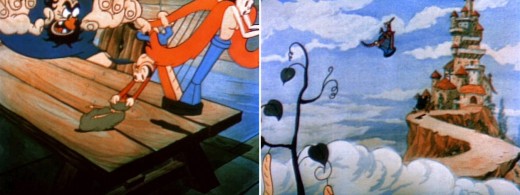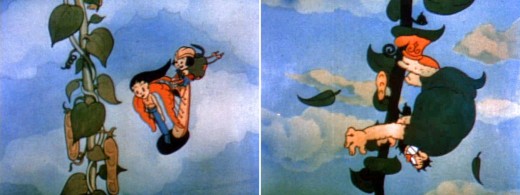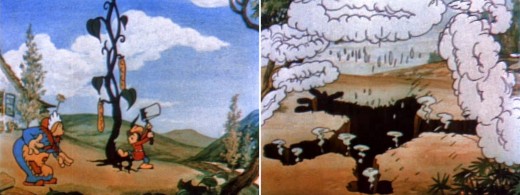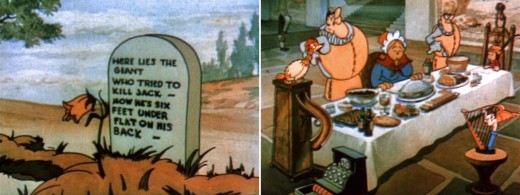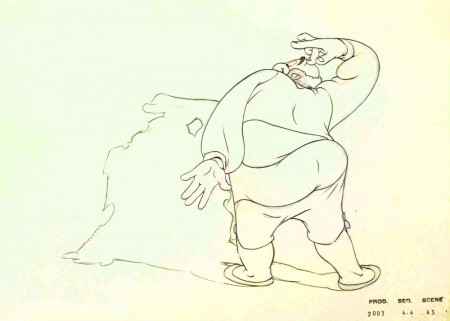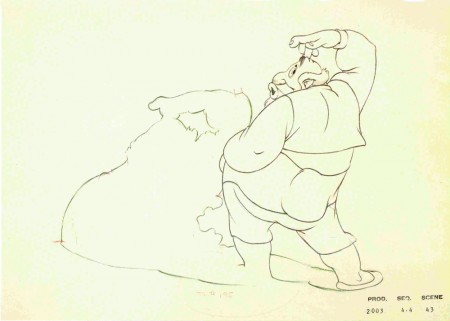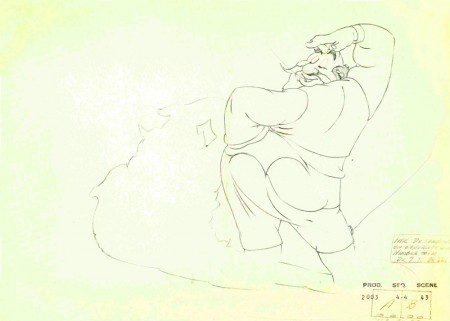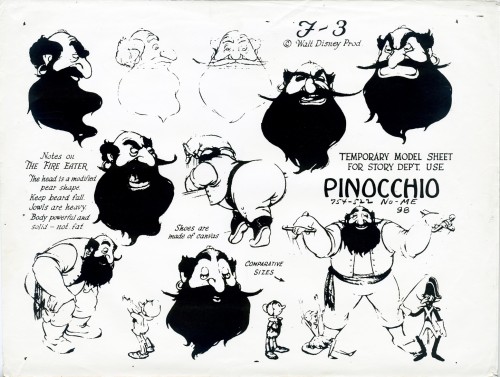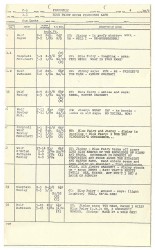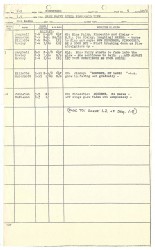Search ResultsFor "stromboli"
Animation &Animation Artifacts &Disney 03 Jun 2009 07:25 am
Tytla’s Stromboli
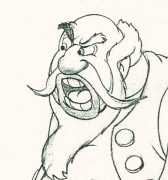 - Bill Tytla‘s work has to be studied and studied and studied for any student of animation. He was the best, and it’s pretty doubtful his work will be superceded. He brought beautiful distortion to many of the drawings he did, using it as a way to hammer home some of the emotions in the elasticity he was creating. Yet, the casual observer watching this sequence in motion doesn’t ever notice that distortion yet can feel it in the strength of the motion.
- Bill Tytla‘s work has to be studied and studied and studied for any student of animation. He was the best, and it’s pretty doubtful his work will be superceded. He brought beautiful distortion to many of the drawings he did, using it as a way to hammer home some of the emotions in the elasticity he was creating. Yet, the casual observer watching this sequence in motion doesn’t ever notice that distortion yet can feel it in the strength of the motion.
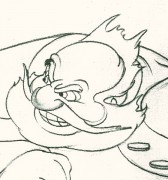
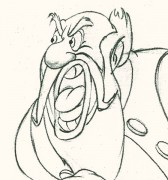
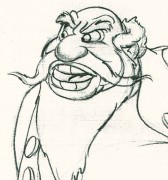
Four drawings (#1, 11, 22, & 48) that shift so enormously but call no attention to itself.
Brilliant draftsmanship and use of the forms.
Here we have the beginning: drawings 1-48. More will come in the future.
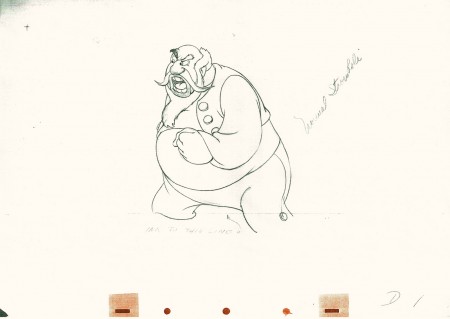 1
1(Click any image to enlarge.) The full scene with all drawings.
Click left side of the black bar to play.
Right side to watch single frame.
Animation &Frame Grabs 01 Jan 2009 09:09 am
Beanstalks
- For New Year’s Day, I’m going to go back to the beginning. My beginning – or at least the day I think I truly came to understand what animation involved and how much I really loved it.
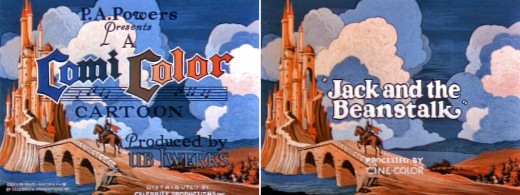
(Click on any image to enlarge.)
I was 12 and had saved my entire summer savings working as a delivery boy for a pharmacist not far from my home. All I made was tips, and the summer had brought me a full $30.
I wanted a projector to watch films. If I was going to make cartoons, I had to have a projector. (Who thought about having a camera to watch them!)
My mother sat down with me – we lived in the Inwood section of far upper Manhattan. She gave me a home-drawn map of the city and told me how I could get there by train. On my own, I took a subway trip to 42nd Street and headed for Peerless Cameras. This was a camera store near Grand Central which would later merge with Willoughby to become Peerless-Willoughby.
They had used 8mm projectors (before the invention of super 8 ), and I intended to go home with one. I did – $25.
Of course, I needed something to project, and Peerless had a VERY LARGE section of entertainment films – 8mm & 16mm. Castle Films distributed many of the Ub Iwerks shorts (most were B&W prints.) They were cut down a bit from the full film, and title cards were edited into them. Obviously, the 8mm projectors and films were silent back then (we’re talking about 1959.)
I’d known the name of Ub Iwerks since I was 8. He was as close to an animation hero as I could muster at that young age. I’d read all about him and knew of the period when he’d had his own studio. There, in Peerless, was Jack and the Beanstalk, and this was the first film I bought.
I felt absolute delight watching that film an endless number of times. The film was, as I said, in B&W, but this actually enhanced some problems old Ub had faced when he started out.
The color paints, for example, weren’t so smooth to lay down. The hand of the bean-seller streaked like crazy and was more obvious in the B&W version. The same was true of the giant’s hand later in the film. Obviously, any time they mixed white into their colors, they couldn’t get it consistent. Terrytoons had this problem well into the 40′s.
It was fun noticing the many elements that made up the film. There were special effects in the film. I’d known that Iwerks was involved in “Special Processes” at the studio (whatever that was – it had to be effects), so you could look at what he did in his own studio. The dark house in the rain storm, illuminated by the lightning was impressive.
Also, the characters were so wacky, you couldn’t help but be entertained by them. The drawing shifted all over the place, but despite the fact that I noticed this – at the age of 12 – I also knew I didn’t mind. You always knew who the characters were even if they went wildly off model.
Every once in a while, there was a hint of a “multiplane-like” effect. When Jack stepped off the beanstalk and onto the clouds, the cel levels move into a position so that the illusion of depth is attempted. It’s handled nicely, I have to say.
Of course, it was a bit of a surprise to find that I couldn’t stop the projector one frame at a time. I wanted to do more than watch the film over and over and over and over and over (which I did.) Eventually, I got tired of this and started tinkering with the machine. I had to be cautious so as not to jar the bulb which could easily burn out and cost me another five bucks.
There was a framing device on the projector. Sometimes the frame line was in the picture and you had to turn this knob to properly frame the picture. By turning this an ungodly number of times, you could actually advance the frames, but you couldn’t see more than about four frames at a time.
That wasn’t quite good enough, so I ultimately started taking the projector apart. I was able to rework the framing mechanism so it could keep going. I was able to watch the film one frame at a time and truly study the animation.
I can’t tell you how many hours I pored over this film.
There was a scene where the giant watches money falling out of the hen’s golden eggs. His one eye follows the coins down (and later follows the rotten egg leaking into the money bag.)
I remembered this scene well when studying some drawings Tytla had done of Stromboli counting his coins. His eyes are similarly loose as they follow the coins to the table, and I wondered if he had known about this giant animation.
Back then, I wasn’t aware that Iwerks hadn’t drawn the entire film by himself. I eventually came to learn that Grim Natwick pretty much ran the studio for quite some time and was replaced, after he’d left for Disney, by Shamus Culhane.
Years later, when I first met up with Grim Natwick, I told him that this film was the very first animated film I’d studied and studied in my goal of becoming an animator. He didn’t offer much of a reaction.
It was a real treat taking this film apart. I started out knowing nothing and soon learned that animation had many decisions and choices behind it. Even today I get a twinge of excitement when I first look at this short – I’m sure it’s as much nostalgia as anything.
In short, it’s all so much easier today. Get a dvd through the mail, look at it on YouTube. Get an animation program like Flash and wallah you’re an animator. There’s no effort. Maybe there was an advantage to having to make an effort.
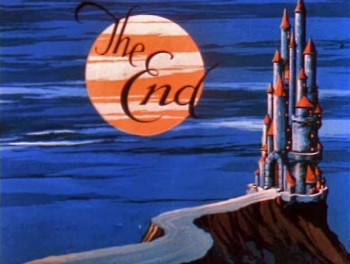
Here’s the link to the YouTube version of the Jack & the Beanstalk.
And here’s the link to vol 1 of The Cartoons That Time Forgot.
Happy New Year
Animation &Animation Artifacts &Disney 25 Aug 2008 07:38 am
Pinocchio moments
Bill Tytla was an amazing character in animation history. I think, far and away, he was onto something that few other animators ever tried to face. He used the drawing, including all aspects: volume, dynamic tension, weight and graphic distortion, at the service of the character’s acting.
I intend, in another post, to draw a comparison with him to Jim Tyer and Rod Scribner.
For the moment, let me show off these great drawings lifted from John Canemaker‘s wonderful book, The Treasures of Disney Animation Art.
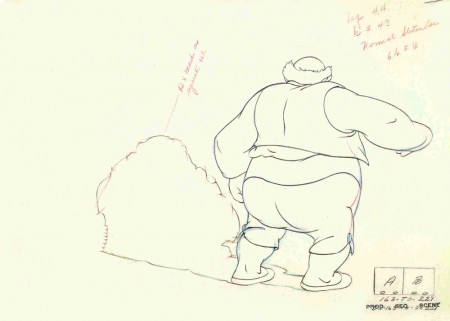
(Click any image to enlarge.)
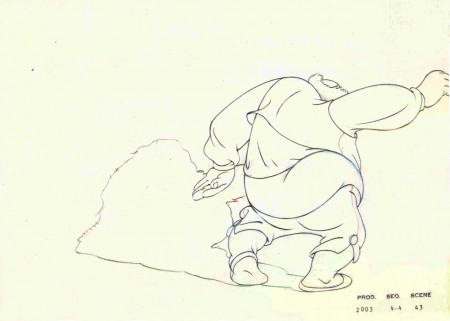
Look at the distortion in these two drawings – 2 & 3
Talk about breaking of joints, talk about stretch and squash,
talk about every possible animation rule and see those rules
stretched to the brink in these great drawings.
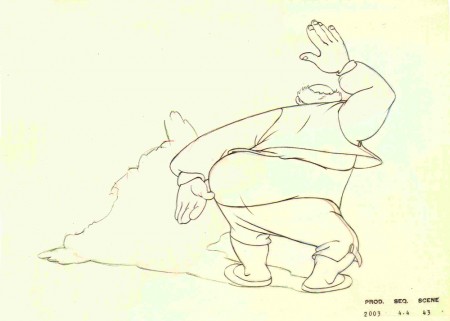
This guy was the master of all masters.
Tytla not only knew the rules but used them to create an acting style
that was on a par with the best of the Method actors of his day.
His kind was never equalled, and I don’t expect to see
anything comparable in cgi. I suppose I can hope.
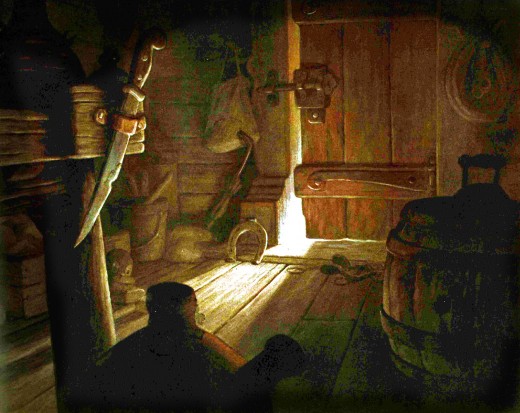
Of course, this is Stromboli’s wagon interior. It’s a beauty.
What a magnificent film!
Animation &Animation Artifacts &Disney 24 Oct 2007 08:04 am
Tytla’s Stromboli
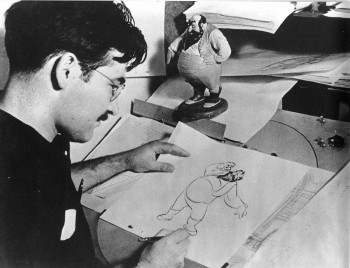 - Mark Mayerson has just completed his final mosaic of Pinocchio. This has been an extraordinary effort on his part, and I can’t say how much I’ve enjoyed it. This film was possibly the pinnacle of traditional animation, and we can’t study it or honor it enough. Mark’s efforts have only elucidated this point more than ever. There’s so much there; the film is an animation treasure.
- Mark Mayerson has just completed his final mosaic of Pinocchio. This has been an extraordinary effort on his part, and I can’t say how much I’ve enjoyed it. This film was possibly the pinnacle of traditional animation, and we can’t study it or honor it enough. Mark’s efforts have only elucidated this point more than ever. There’s so much there; the film is an animation treasure.
One of the gems of the film was Bill Tytla’s animation of Stromboli. A minor character takes on an enormous personality and a major threat to Pinocchio under Tytla’s hands.
The Frank Thomas/Ollie Johnston book, The Illusion of Life, contains a flip book in the upper corner – a short bit of Stromboli flying off the handle. The images are quite small and it’s hard to really see them. I have a slightly larger version of them, so thought I post them as my small tribute to the film.
 1
1
_
 2
2
_
 3
3
_
 4
4
(Click any image to enlarge.)
Commentary 04 May 2007 08:01 am
Brando-style Acting Animated
(Note: I wrote this piece based on Mark Mayerson’s initial comments about acting, and I’m responding to what I read there. He has expounded on those thoughts, and I should react. But I think I’ll let this post sit as it is.)
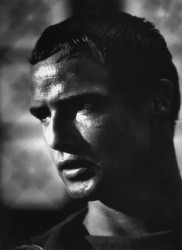 – Mark Mayerson, on his blog, offered enormous and deserved praise for Marlon Brando‘s acting. He then compared it to animation suggesting that no animator has touched the surface of Brando’s work (my phrasing – not Mark’s). This commentary had me mulling about anima-tion and animation acting for the next day or so, and I thought I should comment.
– Mark Mayerson, on his blog, offered enormous and deserved praise for Marlon Brando‘s acting. He then compared it to animation suggesting that no animator has touched the surface of Brando’s work (my phrasing – not Mark’s). This commentary had me mulling about anima-tion and animation acting for the next day or so, and I thought I should comment.
Since I’m prone to ramble, I decided not to overwork Mark’s site with my words and to post it here. Consequently, I think that you might want to read Mark’s not-very-long commentary if you want to continue; go here.
To start with, Mark ends his piece by suggesting that Gollum, the character, is probably the closest that animation has to Brando. This I have to push away from my table with one big stroke.
I don’t understand how a character could be the equivalent of Brando. Even if I thought Gollum were well animated (and I don’t even consider it animation – the way I consider Tytla’s work animation), I would have to compare it to one of Brando’s characters – Stanley, in Streetcar, perhaps.
Perhaps I misunderstand Mark’s thought here.
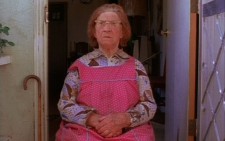 Years ago I was exiting the premiere of Errol Morris‘ first documentary feature, Gates of Heaven. I was shaken, disturbed and said so to my companion. The documentary was an anti-New Wave film. Yet, animation hadn’t even had its own New Wave! (And still hasn’t!) What hope was there for my chosen field?
Years ago I was exiting the premiere of Errol Morris‘ first documentary feature, Gates of Heaven. I was shaken, disturbed and said so to my companion. The documentary was an anti-New Wave film. Yet, animation hadn’t even had its own New Wave! (And still hasn’t!) What hope was there for my chosen field?
Intelligently, my companion reminded me of Yurij Norstein‘s masterpiece, Tale of Tales. I knew she was right; Norstein had pushed animation up to the equal of live action. The future was as much in my hands as documentaries were in Errol Morris‘ hands.
How many times since then have I reminded myself of Tale of Tales?
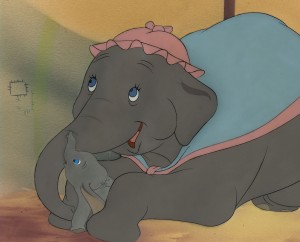 I do think there are animators who were the equivalent of Brando.
I do think there are animators who were the equivalent of Brando.
Tytla was certainly one. I think Tissa David‘s work is on a par with Brando (though I usually think of her closer to Meryl Streep – to me every bit the equal to Brando. (The divine moment in the mediocre film, Devil Wears Prada, where Streep sits in a bathrobe, with bare feet, allowing her vulnerability to escape, before hardening again, has to have been the finest acted moment in film last year.)
The fact that a handful of animators with the knowledge of their craft and the ability to use it didn’t get the work or the part is, to me, irrelevant. If Brando had only played the equivalent of Superman’s father for his entire career, we wouldn’t be talking about him. But he did play that role as well as other mediocre parts, and he played them all extremely well. He also played many masterful roles throughout his career. He gave actors a point in the sky to which they could stretch.
Tytla – there can be no doubt – was in the stratosphere. He is the one we all point to. Stromboli in Pinocchio, Chernobog in Fantasia, Dumbo under his mother’s legs, the dwarfs in Snow White. Can there be any greater acting? The fact that he was forced out of Disney’s studio to the lacking resources of Terrytoons had to affect everything he did. There was no possibility of his continuing the brilliant work. He was subjected to be Superman’s father for the rest of his career.
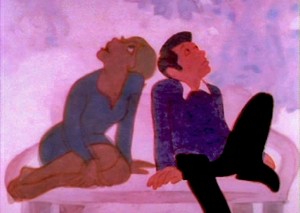 Tissa David is an animator who has made a career of the little human touches among those brilliantly drawn characters of hers. She has worked always on a very tight budget with high footage rates. She has had projects the equivalent of some of those Tytla Disney films, but she was always forced to the ground with their Independent budgets. She has had a couple of large budget projects that had poor stories and/or characters that she had to develop. The fact that she has not always had the great budgets to support her great characters has not hurt her work. She is still a great actress, and her characters – even on three’s – live. Unfortunately, most of her work has been done in the regional theater of animation where the audiences aren’t massive. However, she has made gold of what was handed her, and her talent and abilities are every bit the equal of Brando – and Streep.
Tissa David is an animator who has made a career of the little human touches among those brilliantly drawn characters of hers. She has worked always on a very tight budget with high footage rates. She has had projects the equivalent of some of those Tytla Disney films, but she was always forced to the ground with their Independent budgets. She has had a couple of large budget projects that had poor stories and/or characters that she had to develop. The fact that she has not always had the great budgets to support her great characters has not hurt her work. She is still a great actress, and her characters – even on three’s – live. Unfortunately, most of her work has been done in the regional theater of animation where the audiences aren’t massive. However, she has made gold of what was handed her, and her talent and abilities are every bit the equal of Brando – and Streep.
And there is Tale of Tales. Norstein has done it many times from that truly adult film, to Hedgehog in the Fog or The Heron and The Crane. The direction is brilliant, the filmmaking superb, and the acting equal to the greatest. The unfortunate part is that he has done so little work since the fall of the USSR. (Check out the beautiful and recent Winter Days.)
Brando’s acting style came out of the Actors’ Studio which was an outgrowth of the Group Theater which grew out of Stanislavsky. I always like to think back on a comment John Hubley told me. He said that a small number of those at the Disney were ardent advocates of Stanislavsky, but the rest of the studio couldn’t spell it. Tytla was definitely one of the advocates; just take a look at Chernobog and try to argue otherwise. Tissa came out of France at just the time that the French New Wave started to spark. She went to work under the wing of Grim Natwick who was also one of the Stanislavsky devotees.
Mark is right that there are very few people who could be tagged with such greatness. Most of those I can think of are dead or are no longer working.
These days acting techniques and stylization has grown so enormously sophisticated. Animation abilities have gone in the opposite direction. Today, in animation, it’s all about the broad gesture. I don’t think there is anyone among the young stretching – or trying to stretch – to the same heights, and I’m not sure there will be any more. Though I can hope
- By the way, you should already know that Mark Mayerson has been posting enormously 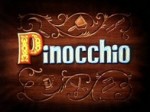 valuable information with his breakdowns and analysis of Pinocchio, scene for scene.
valuable information with his breakdowns and analysis of Pinocchio, scene for scene.
It would be wonderful if somehow Mark got this bound in a published volume. He’s just posted the seventh part of his notes on the “Mosaics” he’s been doing of this monumental film. If you have any interest in animation, you should be following these posts.
Animation Artifacts &Story & Storyboards 23 Mar 2007 08:11 am
Pinocchio Rides
- Well, we’re going to skip a couple of sequences for the next storyboard segment I have available from Pinocchio. The first is the Lobster Inn where we meet the coachman as he conspires with Foulfellow the Fox and Gideon the cat. They plot on kidnapping little children for a coach ride to Pleasure Island.
The boards seem to be missing all of Stromboli and Pleasure Island. I’ll post what I have.
Again, I’m splitting these boards in two laterally for the largest size resolution.
Thanks, once more, to John Canemaker; Borge Ring for giving them to John, and Dave Hand for giving them to Borge.
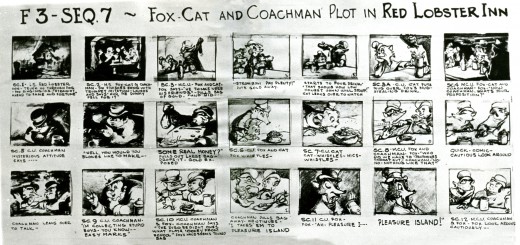 1a
1a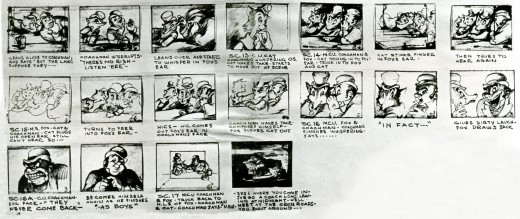 1b There’s a nice flow to some of this page and some decent reaction shots which we hadn’t seen in any other of this board.
1b There’s a nice flow to some of this page and some decent reaction shots which we hadn’t seen in any other of this board.
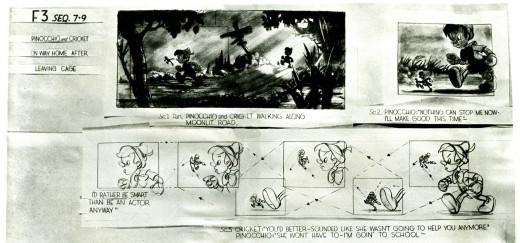 2a
2a 2b
2b
This page seems a bit different than others. The images are a bit more detailed and are spread out. I’m still not sure what purpose these boards served. Interesting that the images are taped and not pinned up. They’re obviously storyboard images regathered for some purpose, possibly a publication.
MONSTRO on Monday.
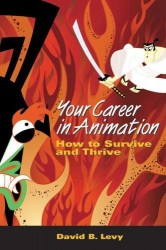
ASIFA-East President, David Levy, will be on radio today. The show NON FICTION is hosted by Harry Allen. Tune into WBAI-NY / 99.5 FM at 2:05 PM. The segment is scheduled to last 20 minutes.
Listen on line here.
Animation Artifacts &walk cycle 21 Feb 2007 07:54 am
He’s Got Strings
- Hans Perk, on his site A Film LA, has been posting the complete set of Drafts for Pinocchio, and after my post of the Jiminy Cricket run last week, I feel compelled to give more from this great Disney film.
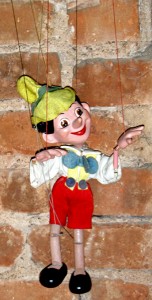 I have this walk – Pinocchio with strings, as operated by Gepetto from above. It’s one of the most complex problems I can imagine, and I think you have to be something of a genius animator to pull it off. Needless to say, Frank Thomas did. He mastered all the challenges of the weight of the object to allow you to completely disbelieve you were watching drawings move, yet you were able to get into the mind of the puppeteer.
I have this walk – Pinocchio with strings, as operated by Gepetto from above. It’s one of the most complex problems I can imagine, and I think you have to be something of a genius animator to pull it off. Needless to say, Frank Thomas did. He mastered all the challenges of the weight of the object to allow you to completely disbelieve you were watching drawings move, yet you were able to get into the mind of the puppeteer.
It’s a brilliant piece of acting. A lifeless creature given life through Gepetto’s manipulation. The scene, of course, contrasts with the “Got No Strings” number where Pinocchio dances among puppets that are manipulated by the professional puppeteer, Stromboli, as opposed to the non-professional, Gepetto. It’s so complex yet done so well that it looks simple.
The drafts list this film as Prod. F3, but the drawings are labelled as F5. I’m not sure what else F5 could stand for since it’s certainly not the seq or sc number. Confusion on my part.
Here they are. Enlarge all images by clicking them.
![]() Note that the drawings read from Right to Left:
Note that the drawings read from Right to Left:
.
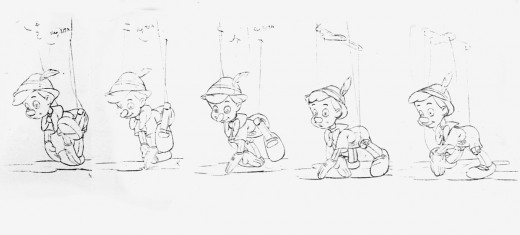
I love Pinocchio’s hand grazing the ground as he’s moved forward. The thrust of his body is all in the head, butt and upper back, as are most marionettes. The strings are an extension of the puppeteer’s hands.
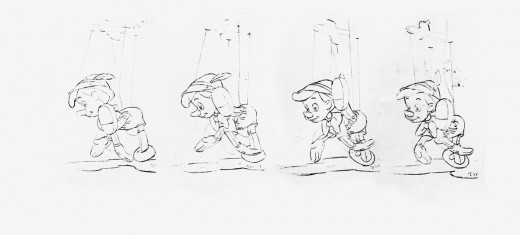
As the foot moves around the rest of the puppet is spun around, too. It’s a beautiful and graceful turn.
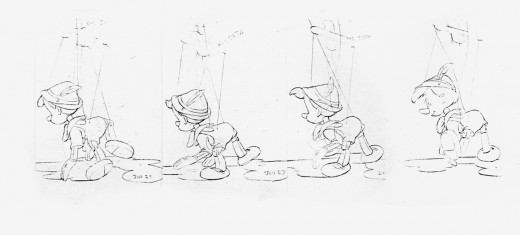
His foot slaps down, and again the hand touches the ground as the puppet prepares to be lifted forward by the offscreen control demands in the play against gravity.
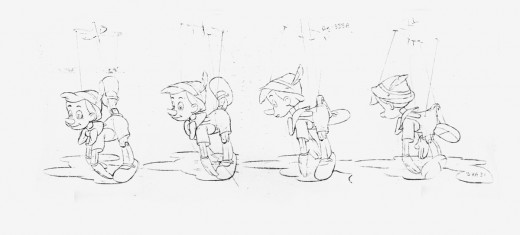
As the back leg goes up and around, the smiling face comes back around to us. Pinocchio’s butt is up there with that foot. A great puppeteer wouldn’t have Pinocchio bent over in this walk, as we see later in Stromboli’s characters.
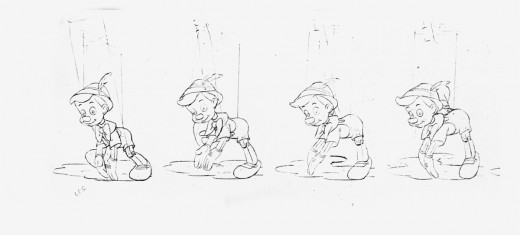
Finally, Pinocchio comes back to the starting point as if this were a normal walk cycle. What a gem of a piece. There were brilliant animators going at it at that studio. Technically, this can be done by some of today’s 2D animators, but I wonder if the meat of the scene would be as good.
Animation Artifacts 27 May 2006 07:19 am
Last of the Pinocchio Drafts
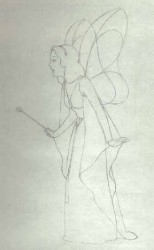 – These are the last of the drafts I have for Pinocchio.
– These are the last of the drafts I have for Pinocchio.
They continue from the last sheet I had posted where Jiminy was getting the clocks to finally quiet down and preparing to go to sleep (posted back in April) , and these which represent the arrival of the Blue Fairy.
I’m curious about the design of the Blue Fairy in this film. She’s markedly different than any other character in Pinocchio. They filmed the entire movie to use as a reference guide for the animators, but only the Blue Fairy is so tightly linked to the rotoscoped drawings. However, it seems quite appropriate for her to be different; the other-worldly quality is enhanced by the rotoscope and the effects glimmering off her dress and eyes and the glow around her body. It’s beautiful.
However, her difference accents the difference that was starting to show up in acting styles among the animators. Tytla and Babbitt, roommates for a long while, couldn’t have been more different in styles.
Geppetto is probably Babbitt’s greatest animation; the character is complex in design and simple in spirit. He feels a bit like an older man being played by a masterful young actor.
Stromboli is an explosive temperament on display. The character even distorts between poses to accent that violence. Oddly, in small ways, this character reminds me of Grim Natwick’s giant in the Iwerks film, Jack & The Beanstalk . Stromboli is much more complex, but his roots are still back there in that theatrical crudeness of the earlier 30′s.
The Disney studio was at the height of its sophistication, and they were beginning to be more demonstrative about it.
If anyone out there has more of the Pinocchio drafts, we’d all love to see them.
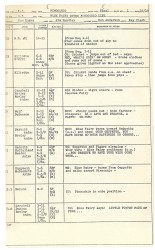
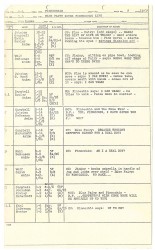
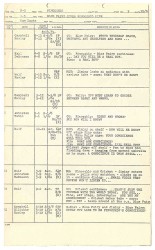
(Click on any image to enlarge.)
